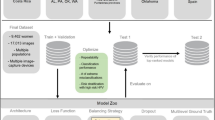Abstract
Image quality control is a critical element in the process of data collection and cleaning. Both manual and automated analyses alike are adversely impacted by bad quality data. There are several factors that can degrade image quality and, correspondingly, there are many approaches to mitigate their negative impact. In this paper, we address image quality control toward our goal of improving the performance of automated visual evaluation (AVE) for cervical precancer screening. Specifically, we report efforts made toward classifying images into four quality categories (“unusable”, “unsatisfactory”, “limited”, and “evaluable”) and improving the quality classification performance by automatically identifying mislabeled and overly ambiguous images. The proposed new deep learning ensemble framework is an integration of several networks that consists of three main components: cervix detection, mislabel identification, and quality classification. We evaluated our method using a large dataset that comprises 87,420 images obtained from 14,183 patients through several cervical cancer studies conducted by different providers using different imaging devices in different geographic regions worldwide. The proposed ensemble approach achieved higher performance than the baseline approaches.
Access this chapter
Tax calculation will be finalised at checkout
Purchases are for personal use only
Similar content being viewed by others
References
Jeronimo, J., Massad, L.S., Castle, P.E., Wacholder, S., Schiffman, M.: Interobserver agreement in the evaluation of digitized cervical images. Obstet. Gynecol. 110, 833–840 (2007)
Hu, L., Bell, D., Antani, S., Xue, Z., Yu, K., Horning, M.P., et al.: An observational study of deep learning and automated evaluation of cervical images for cancer screening. J. Natl. Cancer Inst. (JNCI) 111(9), 923–932 (2019)
Xue, Z., Novetsky, A.P., Einstein, M.H., et al.: A demonstration of automated visual evaluation of cervical images taken with a smartphone camera. Int. J. Cancer (2020). https://doi.org/10.1002/ijc.33029
Desai, K.T., et al.: The development of “automated visual evaluation” for cervical cancer screening: the promise and challenges in adapting deep-learning for clinical testing: interdisciplinary principles of automated visual evaluation in cervical screening. Int. J. Cancer. 150(5), 741–752 (2022). https://doi.org/10.1002/ijc.33879
Guo, P., et al.: Ensemble deep learning for cervix image selection toward improving reliability in automated cervical precancer screening. Diagnostics 10(7), 451 (2020)
Xue, Z., et al.: Cleaning highly unbalanced multisource image dataset for quality control in cervical precancer screening. In: Santosh, K., Hegadi, R., Pal, U. (eds.) Recent Trends in Image Processing and Pattern Recognition, pp. 3–13. Springer, Cham (2021). https://doi.org/10.1007/978-3-031-07005-1_1
Guo, P., Singh, S., Xue, Z., Long, L.R., Antani, S.: Deep learning for assessing image focus for automated cervical cancer screening. In: IEEE EMBS International Conference on Biomedical & Health Informatics (BHI) (2019). https://doi.org/10.1109/BHI.2019.8834495
Ganesan, P., Xue, Z., Singh, S., Long, L.R., Ghoraani, B., Antani, S.: Performance evaluation of a generative adversarial network for deblurring mobile-phone cervical images. In: Proceedings of IEEE Engineering in Medicine and Biology Conference (EMBC), Berlin, Germany, pp. 4487–4490 (2019)
Xue, Z., Angara, S., Levitz, D., Antani, S.: Analysis of digital noise and reduction methods on classifiers used in automated visual evaluation in cervical cancer screening. Proc. SPIE Int. Soc. Opt. Eng. 11950, 1195008 (2022). https://doi.org/10.1117/12.2610235
Shen, Y., Sanghavi, S.: Learning with bad training data via iterative trimmed loss minimization. In: ICML (2019)
Pleiss, G., Zhang, T., Elenberg, E., Weinberger, K.Q.: Identifying mislabeled data using the area under the margin ranking. In: Proceedings of the 34th International Conference on Neural Information Processing Systems (NeurIPS), pp. 17044–17056. Curran Associates Inc., Red Hook, Article 1430 (2020)
Zhang, Z., Sabuncu, M.R.: Generalized cross entropy loss for training deep neural networks with noisy labels. In: Proceedings of the 32th International Conference on Neural Information Processing Systems (NeurIPS) (2018)
Patrini, G., Rozza, A., Krishna Menon, A., Nock, R., Qu, L.: Making deep neural networks robust to label noise: a loss correction approach. In: Conference on Computer Vision and Pattern Recognition (CVPR) (2017)
Northcutt, C., Jiang, L., Chuang, I.: Confident Learning: Estimating Uncertainty in Dataset Labels. J. Artif. Intell. 70, 1373–1411 (2021). https://doi.org/10.1613/jair.1.12125
Desai, K.T., et al.: Design and feasibility of a novel program of cervical screening in Nigeria: self-sampled HPV testing paired with visual triage. Infect. Agent Cancer 15(60) (2020). https://doi.org/10.1186/s13027-020-00324-5
Wang, S.S., et al.: Human papillomavirus cofactors by disease progression and human papillomavirus types in the study to understand cervical cancer early endpoints and determinants. Cancer Epidemiol Biomarkers Prev. 18(1), 113–120 (2009). https://doi.org/10.1158/1055-9965.EPI-08-0591
Lin, T., Goyal, P., Girshick, R., He, K., Dollar, P.: Focal loss for dense object detection. IEEE Trans. Pattern Anal. Mach. Intell. 42(02), 318–327 (2020)
Herrero, R., Wacholder, S., Rodriguez, A.C., et al.: Prevention of persistent human papillomavirus infection by an HPV16/18 vaccine: a community-based randomized clinical trial in Guanacaste, Costa Rica. Cancer Discov. 1(5), 408–419 (2011)
Zhang, H., et al.: ResNeSt: split-attention networks. https://arxiv.org/abs/2004.08955
Liu, Z., et al.: Swin transformer: hierarchical vision transformer using shifted windows. In: 2021 IEEE/CVF International Conference on Computer Vision (ICCV), Montreal, QC, Canada, pp. 9992–10002 (2021)
Northcutt, C., Athalye, A., Mueller, J.: Pervasive label errors in test sets destabilize machine learning benchmarks. In: The 35th Conference on Neural Information Processing Systems (NeuIPS) (2021)
Acknowledgement
This research was supported by the Intramural Research Program of the National Library of Medicine (NLM) and the Intramural Research Program of the National Cancer Institute (NCI). Both NLM and NCI are part of the National Institutes of Health (NIH). The NET study was supported partly by Global Good. The authors also want to thank Farideh Almani at NCI for her help.
Author information
Authors and Affiliations
Corresponding author
Editor information
Editors and Affiliations
Rights and permissions
Copyright information
© 2022 The Author(s), under exclusive license to Springer Nature Switzerland AG
About this paper
Cite this paper
Xue, Z. et al. (2022). Image Quality Classification for Automated Visual Evaluation of Cervical Precancer. In: Zamzmi, G., Antani, S., Bagci, U., Linguraru, M.G., Rajaraman, S., Xue, Z. (eds) Medical Image Learning with Limited and Noisy Data. MILLanD 2022. Lecture Notes in Computer Science, vol 13559. Springer, Cham. https://doi.org/10.1007/978-3-031-16760-7_20
Download citation
DOI: https://doi.org/10.1007/978-3-031-16760-7_20
Published:
Publisher Name: Springer, Cham
Print ISBN: 978-3-031-16759-1
Online ISBN: 978-3-031-16760-7
eBook Packages: Computer ScienceComputer Science (R0)







